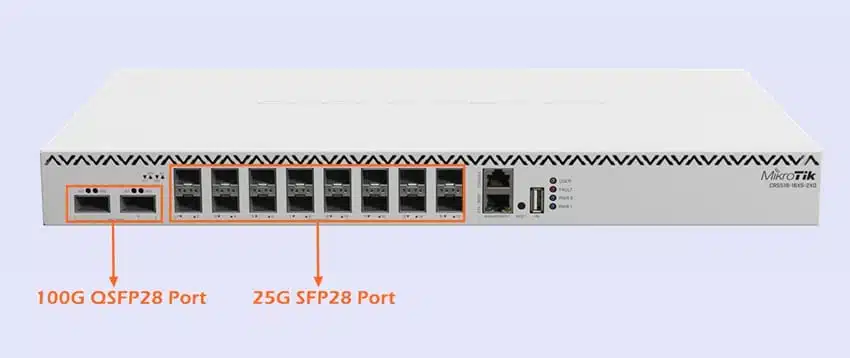

 Knowledge Base +
Knowledge Base +  2023.12.07
2023.12.07If you are a new man to the networking industry, you may also hear about other related words, such as SFP+ port, XFP port, SFP28 port and QSFP28 port.
Now let’s take a simple look at those words.
SFP port is the most common way to call. However, we may also refer to the SFP high-speed port as an SFP+ port, such as 8G, 10G, and 16G data rates.

Figure : 100G Ethernet switch port note, image source
SFP28 port supports 25Gbps data rate, but with the same apperance and demension like SFP port. Sometimes, it is back-compatible with SFP+ port and supports 10Gbps; That is depends on the switch manufacturer setting.
XFP port is a physical slot that accepts XFP module plug-ins. It is only for 8G and 10G XFP transceivers but doesn’t support other speeds.
QSFP28 port is primarily for a much higher speed of 100G. Unlike the SFP port, it not only supports a higher-speed transceiver, but also features a bigger size and more pins on the connector.
In a word, SFP, SFP+ and SFP28 port have the same size and refers to the same thing except for the support speed. The QSFP28 port is of different types and is suitable for 100G data center switches.
Below table list the comparison between them.
| Comparison | RJ45 Port | SFP Port | SFP+ Port | SFP28 Port | XFP Port | QSFP28 Port |
| Reach | max 100m | max 180km | max 100km | max 80km | max 100km | max 80km |
| Data Rate | 1000M, 2.5G, 5G, 10G | 155M, 622M, 1G, 2G, 4G | 8G, 10G, 16G | 25G | 8G, 10G | 100G, 112G |
| Power Consumption | Medium | Lowest | Low | Low | Medium | High |
| Price | Low | Lowest | Medium | Medium | Medium | High |
| Size | Small | Small | Small | Small | A bit Bigger | A bit Bigger |
| Application | Access Switches | Access Switches | Campus Switches | Campus Switches, 5G Fronthaul Network | Campus Switches | Data center switch |
| Media Type | Only Copper | Fiber or Copper | Fiber or Copper | Fiber or Copper | Fiber or Copper | Fiber or Copper |
Table:RJ45, SFP, SFP+, SFP28, XFP, QSFP28 port difference
Subscribe to the newsletter
for all the latest updates.
2-5# Building, Tongfuyu Industrial Zone, Aiqun Road, Shiyan Street, Baoan District, Shenzhen. China
